I tied my first fly before my kids were born. That makes it about 30 years ago when this is written
I tied my first fly before my kids were born, and since the oldest one is turning 28 next time, my guess that it's about 30 years ago - a couple of years before I became a father.
I had started fly fishing after a very short stint of spinning. This was the second fishing period in my life. As many other anglers I had started out as a kid, mainly together with my dad who was an avid fly-fisherman and mostly on family outings with him, my brother, my uncles and cousins. And spin fishing only. Fly-fishing was for grown ups it seemed.
When rock music, school, girls, beer
and whatnot entered my life, fishing was sent into the shadows.
But I started again in connection with traveling in the Arctic during university and not long after having started spin fishing I bought my first fly rod and took up fly fishing. I have a cousin, Erik, who has been fishing as long as I remember, and I went on a night trip to the west coast of the island together with him and a couple of other seasoned fly-anglers.
I took three things back from that trip: a passion night fishing, a passion for muddlers and the spark to start tying. Actually one led to the other, which led to the third.
One of Erik's friends, whose name evades me, looked into my measly flybox to help me select a fly for the evening, but obviously felt nothing but pity, and dug out a couple of really nice muddlers from his own box, which contained endless rows of identical flies. My own box had one of each pattern, lots of variation (in the bad way) and nothing useful for the night.
I tied on one of his muddlers, and even though I didn't catch anything I saw both fish in the surface and fell in love with the small wake made by the floating fly.
Soon after I was in my local flyshop
asking for muddlers.
- Haven't got any, the clerk, Brian, said. - Tie your own.
- Well, I don't tie...
- Learn it!, he said.
He proceeded to the vise set up in the store, dug out some marabou, a patch of deer hair and produced a very decent muddler within a minute or two.
How hard can it be?
I of course left the shop with a bag full of cheap Indian tools, some deer hair and assorted tying materials. Not exactly what I had planned, but then again: that's what skilled salesmen can do to blue eyed customers like I was back then.
How hard can it be?
Later I sat down
and tried to tie my first fly. In hindsight a muddler was probably not the best choice for a beginner's fly. And tying it from the dense and hard black deer hair that I had bought didn't make it easier (Brian should have warned me there!), and of course the fly never really happened. You can see a couple of first or second generation muddlers from my hand on this page, and they sure look like something the cat had dragged in after a hefty fight.
I soon realized
that muddlers weren't going to give me any immediate gratification at the vise, so I ventured into something a little less challenging. I had bought Danish Jan Grünwalds book "Sea trout on spin and fly" - "Havørred på spin og flue" - a true classic on the subject, but only available in Danish and maybe Swedish and/or Norwegian.
This book also covered a few patterns, and made me start the never ending fly-tying materials arms race, because I soon realized that without an ample stock of basically everything, I'd never be able to produce anything.
I made the same error
as most beginners, and bought the cheapest I could lay my hands on. And of course got the lousiest I could get, making life at the vise a constant struggle. All my materials were generally too bad quality: hackles too soft and long, thread too thick, feathers too fluffy, colors wrong, hair too curly, raffia to thick, tinsel too crude and so on. Altogether a sure way of making it unnecessarily difficult to tie and get some decent results.
I bought the cheapest I could lay my hands on. And of course got the lousiest I could get
Scattered on this page
you see pictures of some of the earliest flies I tied - and fished. Some even still have tippet tied on them, so they have been in the water. I have tried to shine them up a bit with steam and some grooming, because they come from boxes and bags where they have spent 20-25 years.
But I'm glad that I saved them!
They tell me that I have actually progressed a bit since I started. You can also see some later inventions of mine that show a bit of development and not least a never ceasing desire to experiment. I still do that and have in a way done that from the very beginning of my fly-tying career. It has both been a blessing and a curse. In one way it helped me develop as a tyer, but on the other hand it also kept me from tying some decent and useful flies. Had I stuck to tying proven and trusted patterns, I might have had fewer of these hall of shame flies to look at now, and more flies that I had actually fished till they trashed.
...they come from boxes and bags where they have spent 20-25 years.
What can you learn from this?
1) Don't start off with muddlers!
I have friends who have tied for 20 and 30 years, and still don't master the technique - not even with the best materials and good guiding.
2) Buy few but decent tools.
A good vise, good scissors, one or two ceramic bobbin holders, a bodkin and maybe a good set of hackle pliers. Save the rest for later. Tools can not make up for lacking skills!
3) Stay off beginner's kits
with "everything" in them - vise, tools, materials. Very few have what you need, and most of it is crap. A few kits have good stuff, but rarely for the flies you want to tie.
4) Don't aim at tying with too many "alternative" materials.
What's sold in craft stores might look like what they have in flyshops and be less expensive, but it's not fly-tying grade, and is often neither durable nor fine enough for flies.
5) Buy few, but good materials.
They might seem expensive when you are starting out, but trust me: you will be buying them later on anyway, so in stead of buying cheap first and expensive later, buy the good stuff right away and save money.
6) Aim at tying few similar patterns
that can share materials. That way you might need just one or two saddles or necks (brown and grizzly will take you very far), a few colors of thread, selected dubbing in selected colors, hooks in one or two sizes etc. Consider omitting exotic details from flies that require special materials.
7) Tie with other
and more experienced fly-tyers that can help you learn, select the right materials and maybe lend you what you don't have.
8) If the bug bites you, make room!
You can expect this to become an ever lasting building of stock. You will constantly be buying materials, and you might as well start organizing right away. No matter what cabinet or tying bag you buy, it will be too small, so go for a cheap, expandable system, like bed rollers or generic, stackable plastic boxes with lids. And buy a ton of Ziploc bags in different sizes. They are the fly-tyer's best friends.
9) Don't start tying flies yourself
to save money on flies! If you want to save money, buy finished flies. No matter how expensive they seem, they are less expensive than tools and materials in the long run.
10) Once you get started
, you will find that tying is a hobby in the hobby, giving you lots satisfaction, producing flies like you want them and filling up the off-season with a fun fishing related activity.
I can still struggle with flies, like I did with this streamer, and I'm not the only one. Even the professionals can produce flies as ugly as my worst contraptions.
- Log in to post comments













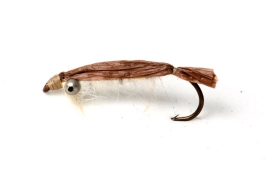
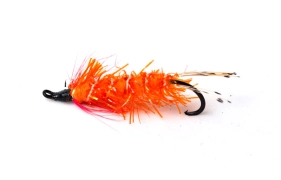



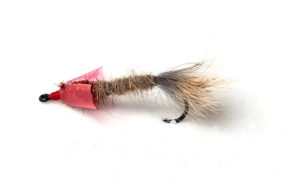


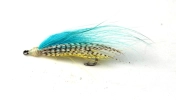










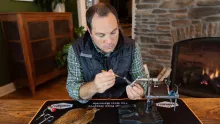






LOL. Just came acros
LOL. Just came across your site and found my early attempt flies looking back at me. Nice site. You know, I still get good hits on some of the crappiest, no rule flies that I produced a few years ago. I now still make them and use them with whatever I can get my mits on that looks "fishy". Maybe when I turn 70 in another 3 years I'll have some time to sit and make some works of art. Until then, I'll fish my ass off.
Hello Martin,
So
Hello Martin,
So recognizable is the story of a beginning fly-tying flyfisherman.
At the moment I have my fifth tying vice after 33 years of fly-tying and are happy with it now! (Stonfo.)
I like this story a lot and have also found a couple of very old flies in my old boxes, flies with a story like yours.
Thanks for telling us,
Best regards,
Tom Biesot.
Most excellent post
Most excellent post sir !!
Adirondackflytyer
Not too shabby, Mart
Not too shabby, Martin. I've been tying for about 40 years and--like you--made every mistake in the book. Worked with crap tools for years. I finally got myself a Renzetti about 10 years ago. I ran across one of my old flyboxes a while back. The little aluminum ones with the coil hook holders. I opened it up and found a couple of dozen bare, rusty hooks and a bunch of dry, mummified moth pupae. :p